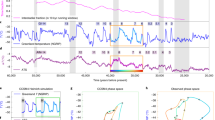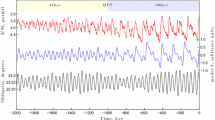Abstract
A model developed recently for the long-term variations of global ice mass, carbon dioxide, and mean ocean temperature through the late Cenozoic is simplified by hypothesizing a new equation for the CO2 variations containing one less adjustable parameter, but retaining the essential physical content of the previous equation (including nonlinearity and the potential for instability). By assuming plausible time constants for the glacial ice mass and global mean ocean temperature, and setting the values of six adjustable parameters (rate constants), a solution for the last 5 My is obtained displaying many of the features observed over this period, including the transition to the near-100 ky major ice-age oscillations of the late Pleistocene. In obtaining this solution it is also assumed that variations in tectonic forcing lead to a reduction of the equilibrium CO2 concentration (perhaps due to increased weathering of rapidly uplifted mountain ranges over this period). As a consequence of this CO2 reduction, the model dynamical system can bifurcate to a free oscillatory ice-age regime that is under the “pacemaker” influence of earthorbital (Milankovitch) forcing. Expanded discussions are given of the surface temperature variations accompanying the evolution of ice, CO2, and ocean temperature, and of the bifurcation properties of the model from both mathematical and physical viewpoints.
Similar content being viewed by others
References
Barnola JM, Raynaud D, Korotkevich YS, Lorius C (1987) Vostok ice core provides 160000-year record of atmospheric CO2. Nature 329:408–414
Berger WH (1982) Deglacial CO2 buildup: constraints on the coral-reef model. Palaeogeogr Palaeoclimatol Palaeoecol 40:235–253
Berger WH, Spitzy A (1988) History of atmospheric CO2: constraints from the deep-sea record. Paleoceanog 3:401–411
Berner RA, Lasaga AC, Garrels RC (1983) The carbonate-silicate geochemical cycle and its effect on the atmospheric carbon dioxide over the past 100 million years. Am J Sci 283:641–683
Boyle EA (1987) Deep ocean circulation, preformed nutrients, and atmospheric carbon dioxide: theories and evidence from oceanic sediments. In: Hsu KJ (ed) Mesozoic and Cenozoic Oceans. Geophys Monogr Ser vol 33, AGU, Washington, DC, pp 49–59
Broecker WS (1982) Glacial to interglacial changes in ocean chemistry. Progr Oceanogr 11:151–197
Broecker WS, Peng T-H (1989) The cause of glacial to interglacial atmospheric CO2 change: A polar alkalinity hypothesis. Global Biogeochemical Cycles 3:215–239
Imbrie J, Hays JD, Martinson DG, McIntyre A, Mix AC, Morley JJ, Pisias NG, Prell WL, Shackleton NJ (1984) The orbital theory of Pleistocene climate: Support form a revised chronology of the marine δ18O record. In: Berger A, Imbrie J, Hays J, Kukla G, Saltzman B (eds) Milankovitch and climate, Part I. Reidel, Hingham, Mass pp 269–305
Keir RS, Berger WH (1983) Atmospheric CO2 content in the last 120000 years: The phosphate extraction model. J Geophys Res 88:6027–6038
Knox FK, McElroy MB (1984) Changes in atmospheric CO2: Influence of marine biota at high latitudes. J Geophys Res 89:4629–4637
Maasch KA (1988) Statistical detection of the mid-Pleistocene transition. Clim Dyn 2:133–143
Maasch KA, Saltzman B (1990) A low-order dynamical model of global climatic variability during the full Pleistocene. J Geophys Res 95:1955–1963
Rau GH, Takahashi T, Des Marais DJ (1989) Latitudinal variations in plankton Sδ13C: implications for CO2 and productivity in past oceans. Nature 341:516–518
Raymo ME, Ruddiman WF, Froelich PN (1988) Influence of late Cenozoic mountain building on ocean geochemical cycles. Geology 16:649–653
Saltzman B, Maasch KA (1988) Carbon cycle instability as a cause of the late Pleistocene ice age oscillations: modeling the asymmetric response. Global Biogeochemical Cycles 2:177–185
Saltzman B, Maasch KA (1990) A first-order global model of late Cenozoic climatic change. Trans R Soc Edinburgh Earth Sciences 81:315–325
Saltzman B, Sutera A (1984) A model of the internal feedback system involved in late Quaternary climatic variations. J Atmos Sci 41:736–745
Shackleton NJ, Opdyke ND (1976) Oxygen-isotope and paleomagnetic stratigraphy of Pacific core V28–239 late Pliocene to latest Pleistocene. In: Cline RM, Hays JD (eds) Investigations of Late Quaternary Paleoceanography and Paleoclimatology, Memoir 145. Geological Society of America, Washington, pp 449–464
Sowers T, Bender M, Raynaud D, Korotkevitch YS (1990) Ice core evidence for a time lag between changes in atmospheric CO2 and the penultimate deglaciation (abstract). EOS 71:538
Takahashi T (1989) The carbon dioxide puzzle. Oceanus 32:22–29
Toggweiler JR, Sarmiento JL (1985) Glacial to interglacial changes in atmospheric carbon dioxide: the critical role of ocean surface water in high latitudes. In: Sundquist ET, Broecker WS (eds) The carbon cycle and atmospheric CO2: natural variations Archean to Present. Geophys Monogr Ser, vol 32, AGU, Washington, DC, pp 163–184
Volk T, Hoffert MI (1985) Ocean carbon pumps: Analysis of relative strengths and efficiencies in ocean-driven atmospheric CO2 changes. In: Sundquist ET, Broecker WS (eds) The carbon cycle and atmospheric CO2: natural variations Archean to Present. Geophys Monogr Ser, vol 32, AGU, Washington, DC, pp 99–110
Wenk T, Siegenthaler V (1985) The high latitude ocean as a control of atmospheric CO2. In: Sundquist ET, Broecker WS (eds) The carbon cycle and atmospheric CO2: natural variations Archean to Present. Geophys Monogr Ser, vol 32, AGU, Washington, DC, pp 185–194
Author information
Authors and Affiliations
Additional information
This paper was presented at the International Conference on Modelling of Global Climate Change and Variability, held in Hamburg 11–15 September 1989 under the auspices of the Meteorological Institute of the University of Hamburg and the Max Planck Institute for Meteorology. Guest Editor for these papers is Dr. L. Dumenil
Rights and permissions
About this article
Cite this article
Saltzman, B., Maasch, K.A. A first-order global model of late Cenozoic climatic change II. Further analysis based on a simplification of CO2 dynamics. Climate Dynamics 5, 201–210 (1991). https://doi.org/10.1007/BF00210005
Received:
Accepted:
Issue Date:
DOI: https://doi.org/10.1007/BF00210005




